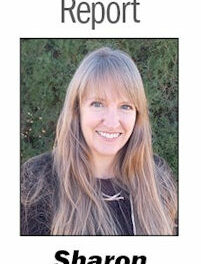
Do we all clearly understand how miserable it is to walk past those roaring behemoth engines and their compressors, across a black asphalt parking lot? It’s often hard to tell if “anyone’s home” inside; we just assume humans are in there, whiling away their gasoline while on their phones. As this behavior intensifies the “urban heat-island effect,” it also stokes a warming planet. But to what degree?
The Department of Energy’s current published data states that idling motor vehicles, both large and small, fritter away 6 billion gallons of fuel yearly. Personal automobiles account for about half that waste. U.S. engine idling also contributes 30 million tons of carbon dioxide to the atmosphere annually. Plus, internal combustion engines exhaust NOX (nitrogen oxide), VOCs (volatile organic compounds), carbon monoxide and soot, all being trapped beneath our stratosphere.
‘Idle idling’ Disparaged
I discovered this rural Montana county’s helpful pamphlet, which wryly observed: “An idling auto is the least efficient car on the road. It gets zero miles per gallon.”
New York City launched its anti-idling campaign with a street dance featuring Billy Idol. The star named a song he composed for the shindig “Billy Never Idles.” Other U.S. cities and numerous states have laws against letting engines idle longer than 30 seconds. All or parts of Massachusetts, Maryland, New Hampshire, New Jersey, New York, Ohio, Pennsylvania, Utah, Vermont, plus Washington, D.C. have “non-essential idling” bans upon the books.
But just which “idle habits” qualify as non-essential? The first is “warming up the engine,” if your vehicle is a later model car. Newer car manuals recommend you begin driving no longer than 10 to 30 seconds after ignition. Catalytic converter technology has rendered “the warm-up” obsolete; so sayeth the DOE! School buses and parent/guardian drop-off/pick-up zones at schools are the second worst culprit of unhealthy idling. Many buses are diesel and kids tend to be short —right at the level of those belching tail-pipes.
And as my pamphlet from good ‘ol Ravalli County, Montana puts it: “Children are particularly vulnerable to air pollution because they breathe faster than adults and inhale more air per pound of body weight.” Well, ok! The next worst occasions for idling are drive-thru lanes, such as fast-food restaurants, banks and espresso cafes. I am entirely culpable in this realm! The problem had never even crossed my mind. Signage is going up at some drive-thru locations, suggesting that stopping and restarting the engine is not a bad thing.
New Habits Emerging
The next major culprit is long-haul trucking. Truck stops, rest areas and crowded ports are disturbing with their incessantly idling big rigs. Training in the skills and equipment to master less idling is helpful; but the planned conversion to all-electric fleets can’t come too soon. Amazon plans to deploy 100,000 all-electric delivery vans by 2030. Another solution to all of the above is how hybrid-electric vehicles automatically shut off when the car isn’t moving, like at stoplights. They restart instantly when you press the accelerator.
The DOE firmly makes a simple, but urgent recommendation, called The 10-second Rule: Turn OFF your engine when stopped for longer than 10 seconds, except in traffic. Folks no longer need to worry about wear on their starters or batteries; these are much more durable now and will last longer if the Rule is applied. Plus, it’s been proven: Over 10 seconds of idling uses more fuel than restarting an engine! Period.
Well, I suppose now, we have winter idling to look forward to: folks just sittin’ out in their rumbling cars, staying warm. Yet some might stop and think …
Sources: Bloomberg; CleanCities.Energy.gov; The Environmental Protection Agency; Ravalli County communications, Montana; U.S. Department of Energy.
U.S. Right to Know (RTK) — Pursuing Truth and Transparency for Public Health was Albrecht’s source for her Oct. 28 column, What’s wrong with Round-Up?


















